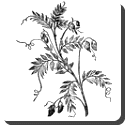 Lentil — The lentil or masoor (Lens culinaris) is a brushy annual plant of the legume family, grown for its lens-shaped seeds. It is about 15 inches tall and the seeds grow in pods, usually with two seeds in each.
Lentil — The lentil or masoor (Lens culinaris) is a brushy annual plant of the legume family, grown for its lens-shaped seeds. It is about 15 inches tall and the seeds grow in pods, usually with two seeds in each.
The plant originated in the Near East, and has been part of the human diet since the aceramic Neolithic, being one of the first crops domesticated in the Near East. With 26% protein, lentil is the vegetable with the highest level of protein other than soybeans, and because of this it is a very important part of the diet in many parts of the world, and especially India which has a large vegetarian population.
A variety of lentils exist with colors that range from yellow to red-orange to green, brown and black. Red, white and yellow lentils are decorticated, i.e. they have their skins removed. One variety of yellow lentils, Chana, is in fact made from the kernels of chickpeas. There are large and small varieties or many lentils (e.g. Masoor Lentils). Lentils are sold in many forms, with or without the skins, whole or split. The urad bean, a species of the genus Vigna, is also referred to as “black lentil”. Split Pigeon peas (either green or yellow) are sometimes erroneously sold as lentils. They are considered pulses, which includes peas and beans.
Lentils’ contribution to heart health lies not just in their fiber, but in the significant amounts of folate and magnesium they supply. Folate helps lower levels of homocysteine, an amino acid that is an intermediate product in an important metabolic process called the methylation cycle. When folate and vitamin B6 are present, homocysteine is immediately converted into cysteine or methionine, both of which are benign. When these B vitamins are not available, levels of homocysteine increase in the bloodstream—a bad idea since homocysteine damages artery walls and is considered a serious risk factor for heart disease.
 Kids Portal For Parents India Kids Network
Kids Portal For Parents India Kids Network






